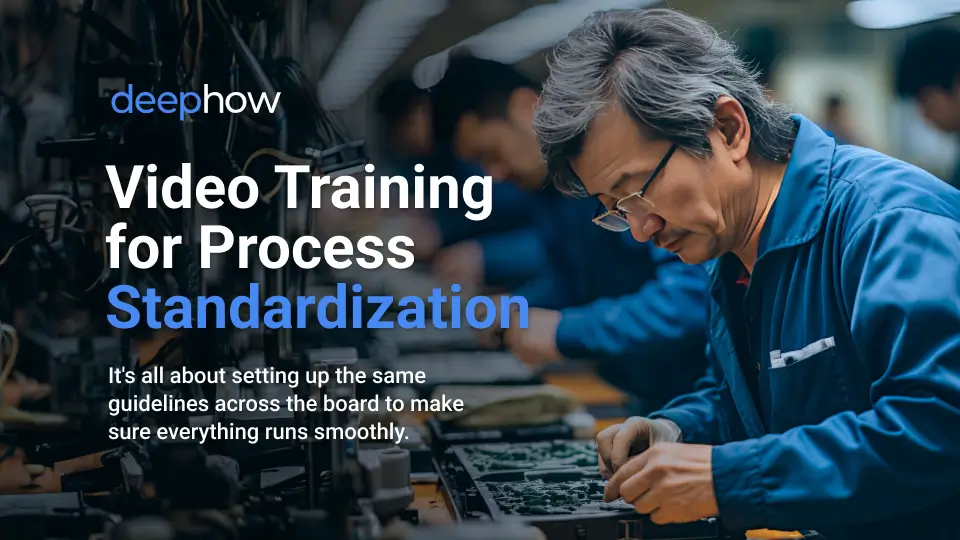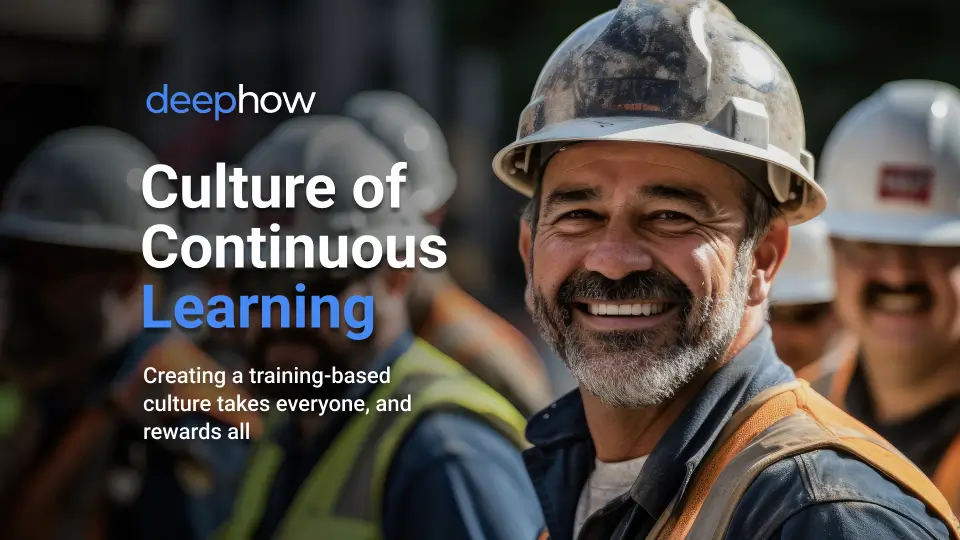
At a high-production factory in the northeastern United States, a worker named Adam was asked to come in during the third shift. He typically only works first, but a machine that he specializes in was down, and there were still many hours to go until his scheduled starting time. These lost hours represented a potentially huge amount of wasted revenue for the company. So, Adam did what any person in his position would do: he got out of bed, dressed quickly, and made the short drive to work. He redressed in the PPE gear required and walked onto the floor to the malfunctioning machine.
After getting within just a few feet of it, he knew exactly what was wrong and what needed to be done to set it right. He didn’t even have to touch it. He was so familiar with this machine that simply by hearing the noise it was making, he could locate the right solution in his mind. Within thirty minutes, the machine was back online, and Adam was heading back to bed. How many times do in-house experts like Adam get calls like this?
How many disrupted weekends and nights are there for those workers that everyone seems to rely on? How frequently are they nervous to plan a trip because they might be needed if something goes wrong?
For one trainer at Anheuser-Busch’s lid-making facility in Oklahoma City, this was his reality. He would find himself working 15-30 hours of overtime each week to help the other shifts, who greatly relied on his expertise to stay productive and solve (or avoid) shutdowns.
When was the last time you considered the in-house experts within your organization? These subject matter experts (SMEs) are the employees who’ve been here long enough to truly understand how things work - and why they don’t. Their deep bench of experience and insights accrued through years of dedicated service is something that can hardly be replicated - but, with the right tools, it can be captured and shared, and these experts can get some well-deserved time back.

The Untapped Potential of In-House Experts
As we reflect on Adam's pivotal role in restoring production efficiency, it becomes clear that the true power of our workforce lies in its collective expertise. These Subject Matter Experts (SMEs), with their deep understanding of our operations, are the linchpins of success in an ever-evolving industry landscape. However, their invaluable insights and tacit knowledge are at risk of being lost forever as retirement - or competition - looms on the horizon.
The reality is that the clock is ticking. With each passing day, seasoned employees like Adam edge closer to retirement, threatening to take their irreplaceable expertise with them. In the US alone, there are an estimated 12 million manufacturing employees over 55, and The National Association of Manufacturers says in the next decade, companies will need to replace over 3 million jobs due to retirement. Now more than ever, organizations must act swiftly to capture, preserve, and leverage the wealth of knowledge residing within their workforce before it walks out the door.
This is where innovative solutions like DeepHow come into play. By providing a platform for capturing and sharing expert knowledge through interactive video content, DeepHow empowers organizations to preserve institutional knowledge, streamline training processes, and ensure continuity in the face of impending retirements. As we delve deeper into the untapped potential of in-house experts, it becomes increasingly evident that leveraging tools like DeepHow is not just a strategic imperative but a necessary step toward securing the future success of our organizations.

Techniques for Identifying In-House Experts
Locating these SMEs within your organization can feel like trying to find a needle in a haystack. But there are plenty of strategies you can employ to uncover these crucial experts. From casual conversations over coffee to formal interviews and digital job shadowing, there are myriad ways to unearth the wealth of expertise lurking in the shadows.
- Encourage Casual Interactions: Foster an environment where employees can engage in informal conversations through activities like coffee breaks, team meals, or social events outside of work. Such relaxed settings allow team members to share knowledge, discuss their experiences, and highlight their expertise in a comfortable atmosphere.
- Structured Interviews and Surveys: Utilize formal interviews or distribute surveys to uncover employees who have significant knowledge and experience in particular fields. Pose specific questions regarding their skills, past experiences, and contributions to identify their level of expertise and potential as SMEs.
- Digital Job Shadowing Initiatives: Launch programs that allow employees to digitally follow their colleagues for a day, observing their daily responsibilities, workflow, and how they tackle challenges. This approach aids in recognizing SMEs while promoting the exchange of knowledge and interdisciplinary learning.
- Solicit Peer Recommendations: Motivate team members to recommend colleagues they consider highly knowledgeable and skilled. Recommendations from peers can offer valuable insights into an individual's unique contributions and knowledge from another vantage point.
- Analyze Performance Reviews: Examine the performance evaluations and feedback of employees to spot those who consistently excel in their skills, knowledge, and ability to solve problems. Identifying patterns of outstanding performance can help pinpoint potential SMEs.
- Track Training Engagement: Observe which employees actively participate in training sessions, workshops, and knowledge-sharing meetings. Focus on those who frequently offer valuable insights, pose thoughtful questions, and show a dedication to ongoing learning and self-improvement.
- Project Leadership Roles: Look for employees who assume leadership positions in projects, initiatives, or collaborative teams. Such individuals typically have a broad range of skills, strong communication abilities, and a penchant for teamwork—all crucial traits for an SME.
Implementing these tactics enables organizations to discover and leverage the untapped expertise within their teams, propelling innovation, nurturing a culture of learning, and achieving superior organizational performance. Once these SMEs have been identified, the real magic begins. Through interactive video content creation and digital storytelling, their insights can be immortalized, transforming mundane training materials into captivating narratives that engage and inspire.

SMEs Should Create Your Training
Imagine a seasoned machinist who can navigate the complexities of a CNC machine with the finesse of a virtuoso pianist, or a welder whose precision rivals that of a surgeon. These individuals aren't just ordinary workers; they're SMEs. Their wealth of experience and deep understanding of their craft make them invaluable assets in the development of training materials that resonate with learners and drive performance excellence.
Many organizational leaders grapple with the dilemma of balancing the invaluable time of skilled workers with the imperative need for comprehensive training. The traditional approach may lead them to consider engaging external consultants or relying on antiquated written standard operating procedures (SOPs). However, these routes come with their own set of challenges and drawbacks.
Engaging external consultants can be brutally expensive, and the time required to bring them up to speed on your processes can cost even more. Furthermore, despite the hefty investment, the input of seasoned workers is still required to ensure the accuracy and relevance of the training content. On the other hand, while written SOPs can still hold significant value if kept up-to-date, they often fall short of meeting the needs and preferences of today's learners.
Studies have consistently shown that video training is more effective than traditional written materials in terms of knowledge retention. Additionally, a staggering 85% of younger learners express a preference for video content over written manuals.
However, the prospect of creating video content through traditional means, such as hiring a video production company, presents its own set of challenges. Not only would costs skyrocket, but the process would also entail taking high-value SMEs away from their critical duties. So, what solution exists that can effectively balance the need for comprehensive training with the preservation of valuable resources?
Transferring Tacit Knowledge to Training
Enter DeepHow: With its cutting-edge software, any trainer can effortlessly capture expertise with the simple push of a button using just their smartphone. Once captured, the video is seamlessly uploaded to DeepHow's desktop editor, which can be swiftly edited and refined to perfection. With the ability to add multiple translations, the content becomes accessible to a diverse workforce, ensuring inclusivity and accessibility.
The true magic of DeepHow lies in its private knowledge library—a centralized hub where captured expertise is stored and easily accessible to colleagues. This comprehensive repository serves as the cornerstone of organizational knowledge, offering a treasure trove of insights that can be easily searched and accessed by newer team members, and is exclusive just to your organization.
Whether it's learning a new skill or refreshing a familiar process, DeepHow's knowledge library simplifies the process of skill tracking and knowledge transfer. Gone are the days of frantic calls to SMEs in the dead of night; with DeepHow, teams can empower themselves with the knowledge they need, whenever they need it.
Imagine if Adam's expertise had been captured within DeepHow's knowledge library. The third-shift team could have swiftly resolved the machine issue independently, without the need for Adam to sacrifice his well-deserved rest. With fewer disruptions and less downtime, everyone—from Adam to the third-shift team—would reap the benefits of a more streamlined and productive operation.
That’s exactly what happened at Anheuser-Busch. After implementing DeepHow, one trainer noticed he got more than 15-30 hours a week back after only creating a handful of training videos.

Capturing Tacit Knowledge
Once you've identified your SMEs, the next step is to capture their tacit knowledge—the valuable insights and expertise in their heads and hands. Here's why video training stands out as an indispensable tool in this process:
- Dynamic Learning Experience: Video training transforms the abstract and nuanced aspects of tacit knowledge into concrete, visual learning experiences. By showcasing SMEs in action—whether it's navigating complex software, executing a skilled task, or troubleshooting in real-time—video brings to life the subtleties and depth of expert knowledge that are often lost in written documentation.
- Bridging the Expertise Gap: Videos create a bridge between experts and novices, enabling the latter to see exactly how tasks are performed from the expert's viewpoint. This visual and auditory learning approach is more effective for capturing the nuances of tacit knowledge, making it easier for learners to absorb and replicate the expert's methods.
- Interactive and Engaging Content: The use of interactive elements in video training, such as linked attachments, comments, and branching skills, engages learners more deeply. This interactivity not only makes learning more engaging but also allows employees to actively apply what they've observed, reinforcing the acquisition of tacit knowledge.
- Accessibility and Flexibility: Video content can be accessed anytime, anywhere, providing learners with the flexibility to learn at their own pace and revisit complex topics as needed. This on-demand access is crucial for reinforcing learning and accommodating different learning styles and schedules. If your team is diverse, DeepHow also makes it easy to translate content into dozens of different languages to meet the needs of your skilled workforce.
- Personalized Learning Journeys: Video training can be customized to address specific learning objectives, skill levels, and roles within the organization. This personalization ensures that the content is relevant and tailored to the learner's needs, enhancing the effectiveness of knowledge transfer.
- Scalable Knowledge Sharing: Once captured, video content can be easily distributed across the organization, making it a scalable solution for disseminating tacit knowledge. This scalability ensures that valuable insights are not confined to silos within the organization but are shared widely, fostering a culture of continuous learning and innovation.
In summary, video training is a key strategy for capturing and disseminating tacit knowledge within an organization. It offers a dynamic, interactive, and accessible platform for translating the rich, unspoken expertise of SMEs into tangible learning experiences that can be shared across the organization, enhancing overall competency and performance.

Encourage a Culture of Sharing
At the heart of effective knowledge transfer lies a culture of sharing—a culture where employees feel empowered to share their expertise, insights, and experiences with their peers. But fostering such a culture is easier said than done. It requires more than just lip service; it requires a concerted effort to create an environment where knowledge sharing is not just encouraged but celebrated, and everyone embraces the spirit of continuous learning. So how do you create such an environment?
It starts with leadership. Leaders must lead by example, demonstrating a commitment to knowledge sharing through their actions and behaviors. They must create opportunities for employees to share their expertise, whether through formal training programs, informal mentoring relationships, or knowledge-sharing platforms. They must recognize and reward employees who contribute to the organization's collective knowledge, reinforcing the value of knowledge sharing and encouraging others to follow suit.








